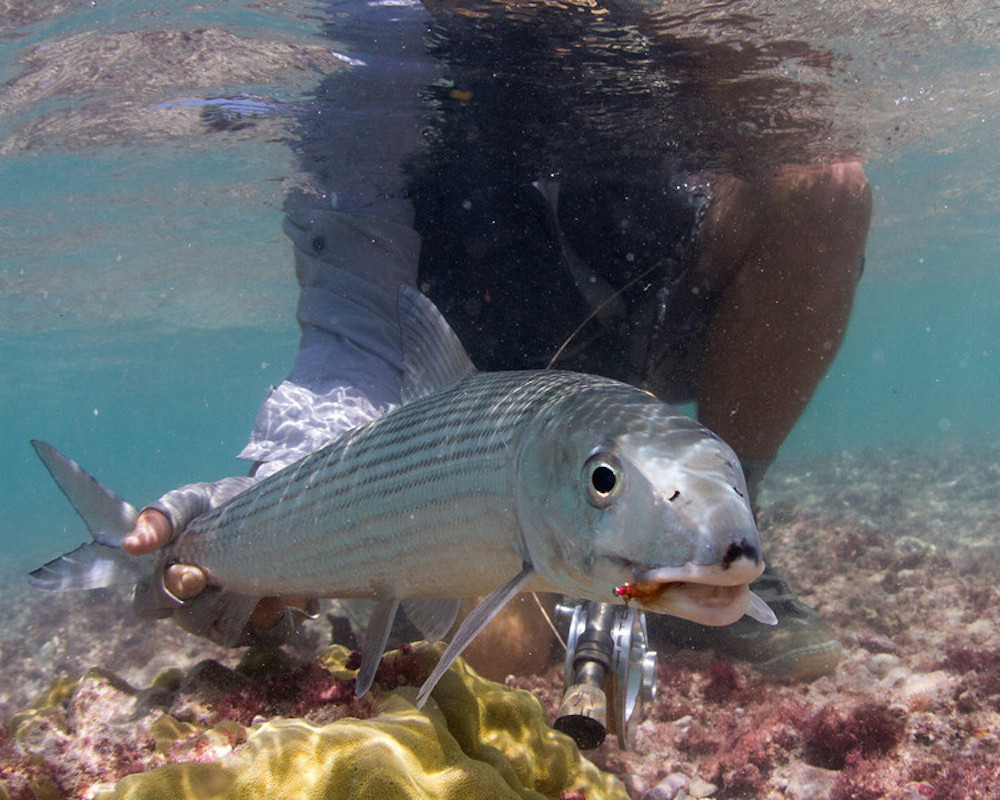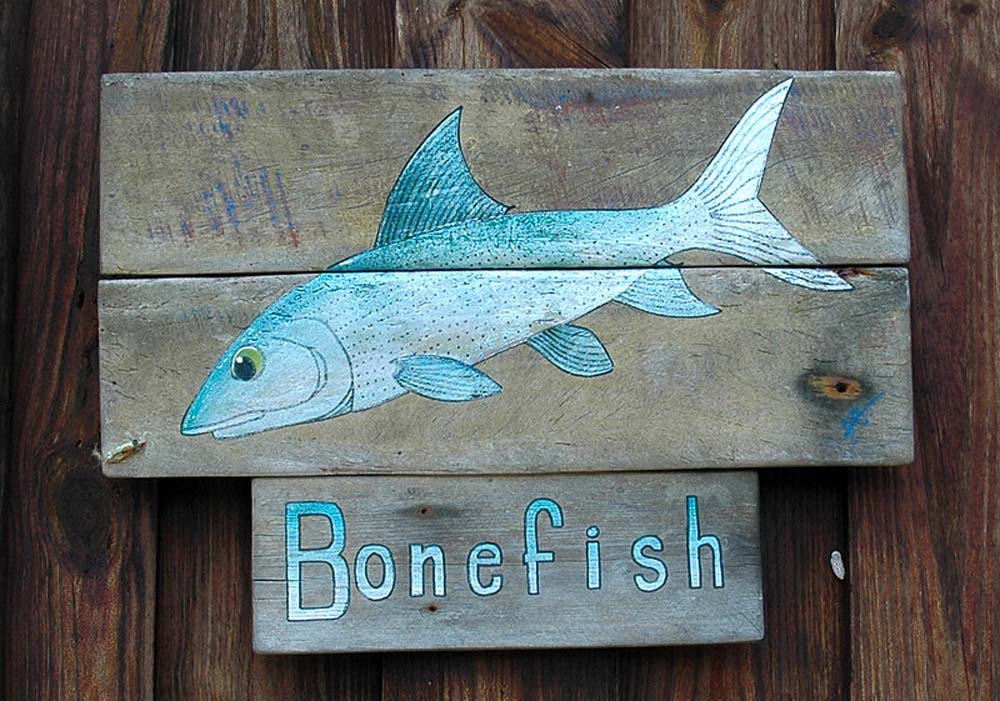
Photo: Jim Klug – Yellow Dog Flyfishing.
Understanding The Bahamas’ bonefish history, and more
Contributors Captain Andrew Derr / Tom Karrow, Ph.D. / Chico Fernandez / Peter McLeod / Aaron Adams, Ph.D. / Sandy Moret / Jim Klug
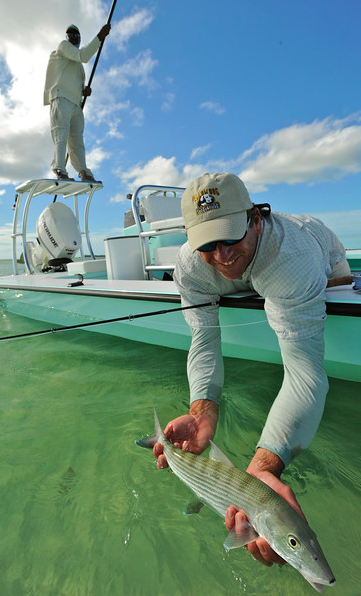
Tom Karrow releasing a nice Bahamas bone. Karrow photo in May, 2014.
By Thomas Karrow, Ph.D. with Jim Klug photos
Background
Thomas Karrow has a Ph.D. from the University of Waterloo, Department of Geography and Environmental Management. His doctoral research centered on using local knowledge and oral history from Bahamian guides to assess the sustainability of the Bonefishing Tourism Sector in The Bahamas. He worked in conjunction with Bonefish and Tarpon Trust, The Fisheries Conservation Foundation, The University of The Bahamas, and Bahamian guiding organizations. Today, Thomas is a consultant in sustainable tourism, CEO of a contracting firm, authors outdoor articles, guides occasionally when time permits, and is writing a book entitled Ghost Stories – A History of Flats Fishing in The Bahamas. The volume will feature elder guides from across The Bahamas to chronicle their oral history and maritime tradition. Thomas can be reached at:
tomkarrow@gmail.com or on IG at coastalfly by tkarrow
The Past
While the earliest pioneering recreational anglers seeking bonefish are long gone, anglers across the globe today share similar experiences and the passion they had. Early accounts of pursuing bonefish for sport are sparse. Like any historical documentation, accuracy can be difficult to assess, and facts are now largely impossible to verify. To the best of our knowledge, bonefish were initially caught as bi-catch when angling for more “desirable” species like snapper – desirability measured by table fare. However, the sporting nature of bonefish quickly caught the attention of recreational anglers. Hook and line with shrimp or crabs were the go-to technique, while jigs and other artificials became useful. Fly-fishing for bonefish was largely a dream at that time, although it is widely practiced today.
Records
Records from the 1910s, ’20s, and ’30’s make mention of bonefishing and anglers like Wulff and Brooks were some of the first officially successful people to capture the Ghost of the Flats. No doubt others with less prominence in the “angling world” were likewise catching bonefish on conventional or fly tackle, but as history passes, so too do related records. Early photos and fishing tournament results can be used to chronicle early bonefishing, but both offer challenges. The late Lefty Kreh once told me that anglers would go bonefishing when the water was too rough to go offshore fishing, a more prestigious affair then. Bonefishing was a backup plan, as he put it.
During my years in The Bahamas, many elder guides spoke highly of bonefish as the best bait for bill fishing, extolling its boney nature and highly reflective skin that made bonefish the ideal live bait. Dragged behind offshore boats in search of prized deep-water Gamefish, bonefish would last all day long, much longer than any other “live” baits. The same guides also told me it was not long ago that bonefish were still being bought and sold for use as bait, and while the practice in The Bahamas is now banned, it may still occur. I was told off the record it does occasionally.
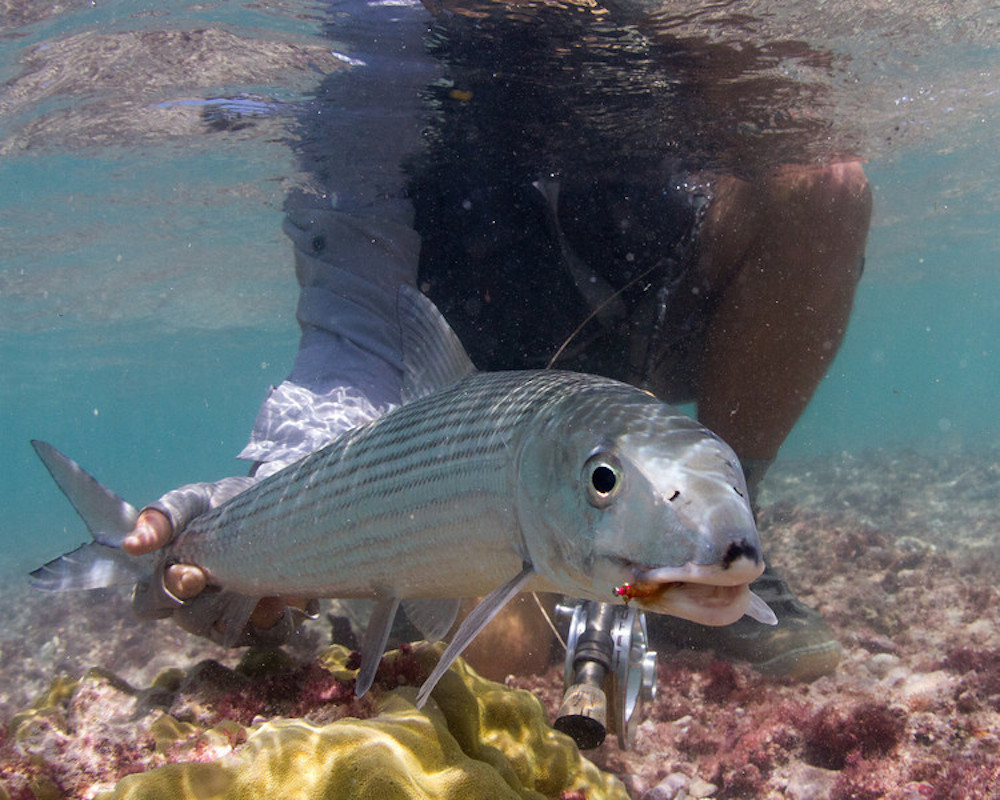
Photo: Jim Klug – Yellow Dog Flyfishing.
Early challenges for anglers
It is a marvel that early anglers succeeded in catching bonefish for many reasons. Traveling to bonefish destinations at that time was considerably more challenging than it is today, making these places even more magical than we find them today. Air travel was not even possible when the first anglers prowled flats with rods and reels. Navigation was archaic compared to today, and the internal combustion engine used in ships was not prominent until the late 1920s or early ’30s. As such, the Florida Keys were the epicenter of early bonefishing successes, and like a pebble thrown into a pond, the ripples of angling interest expanded outward from the Keys. With proximity to the United States and the Florida Keys, The Bahamas became a natural, early destination for anglers seeking bonefish or other tropical species. The first jump from Florida was Bimini, followed in time with bonefishing accounts in Grand Bahama and Andros and then further geographically to the Abacos, The Exumas, and beyond. Because of the need to travel to bonefish destinations, bonefishing was only accessible to those with the financial means necessary to make the arduous journeys across the deep blue seas. The same holds today, although travel is more readily available and arguably much safer.
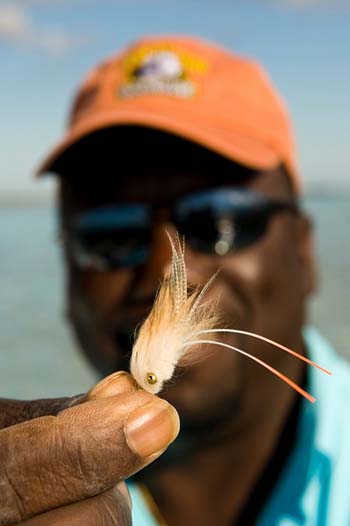
Guess – Photo: Jim Klug – Yellow Dog Flyfishing.
The earliest records of bonefishing exist below our feet. Evidence from Archaeological sites throughout the Caribbean points to the securement of bonefish by native peoples long before European colonization took place. Faunal (animal bone) records from middens (garbage piles) demonstrate that native peoples ate bonefish.
Bonefish inhabit near-shore shallow waters, and they commonly develop observable patterns associated with tides – moving into small creeks on incoming tides, and leaving them as the tide ebbs. Recognizing this is not difficult, and for native peoples inhabiting the many small islands in the Caribbean and likely beyond, these characteristic patterns allowed for a ready supply of food.
A simple net across a creek would produce a steady food supply with little caloric output for the net gain achieved. The challenges with archaeology in tropical island communities are many. Sites over lengthy periods would be subjected to inundation and shoreline erosive tendencies, which would wash away archaeological records. Moreover, damp, humid, and salt-rich soils are harsh on preserving organic materials like bone. As a result, the actual magnitude of faunal remains archived from archaeological sites in the Caribbean is often far less than what might have been. The importance of bonefish as local food fare is more challenging to quantify. However, in the above context, bonefish were easy to catch and common in the diet. Similar netting techniques for bonefish have been employed in The Bahamas until quite recently when catch and release practices and the more lucrative recreational angling sector swayed people against the practice, although I am confident some locals still drop a well-placed net for a meal or two.
Bonefishing abroad
Bonefishing as a sport grew incrementally alongside transport and angling technology changes from the early days to the 80s. The advent of petrochemical advances facilitating monofilament development and a shift from cane rods to fiberglass and graphite rods were pivotal technological advances that magnified growth along the trajectory of bonefishing evolution. Growth in flats fishing for bonefish seemingly peaked in the 1990s, it began to fall as angling pressure, habitat loss, and increasing human population placed overwhelming stresses on fragile ecosystems. Some destinations have continued to falter as historically great bonefish destinations (like West End Grand Bahama or Bimini), others have maintained their fishery (like Andros), some destinations have rebounded (like Exuma or the Florida Keys), and others are just now emerging as highly sought after destinations (like Seychelles). As we now know through tagging research, bonefish habitat ranges are generally small; hence they are very susceptible to change. A minor dredging operation, removal of mangroves on a shoreline, or some other relatively minor environmental impact in a remote destination can have devastating impacts on a local bonefish population, and these sorts of issues are pervasive globally. The history of bonefishing is a rich one with colorful characters in beautiful places.
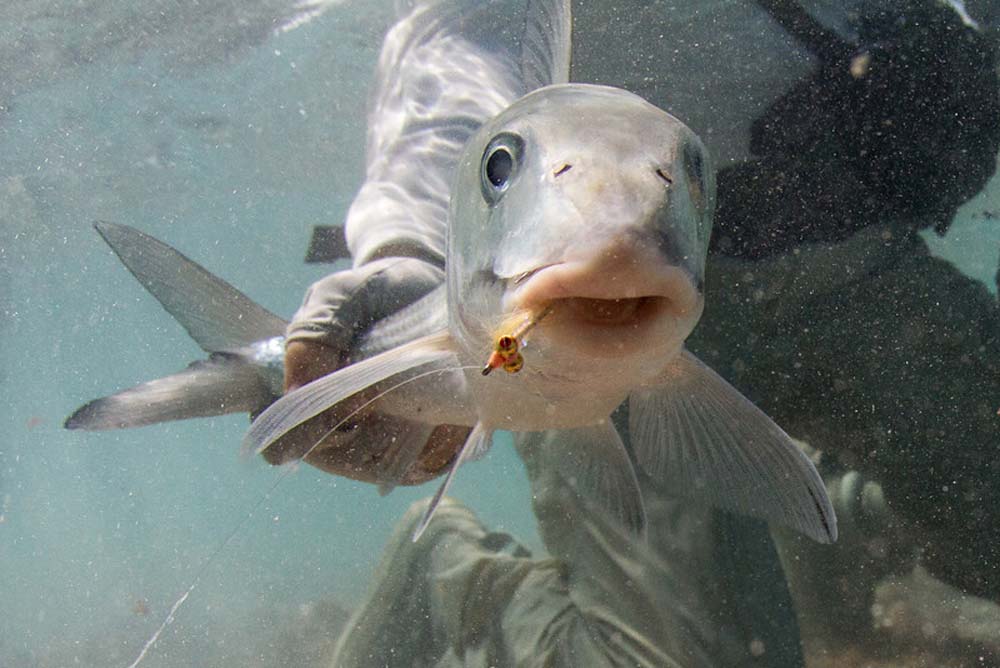
Photo: Jim Klug – Yellow Dog Flyfishing.
The Present
Because most bonefishing anglers need to travel to find bonefish flats, it was a limiting factor in the number of anglers. Today, however, travel is more available to people. It is faster, there are many more destinations to choose from, and we are more connected than ever. Several companies cater specifically to angling travel, and while distance is no longer a barrier, costs are still prohibitive for many. In general, anglers have far more opportunities to pursue and catch bonefish today than ever before, and the technology available to anglers is unparalleled. From lightweight and better casting rods and reels to very strong high carbon chemically sharpened hooks, a multitude of exceptional baits and flies, to shallow draft boats, carbon fiber push poles, GPS units, and Google Earth, anglers can go farther than ever to seek untouched, unpressured, uneducated fish. Catches can be “shared” faster than ever, and the latest “hot” angling destination can quickly become overridden with angling
pressure.
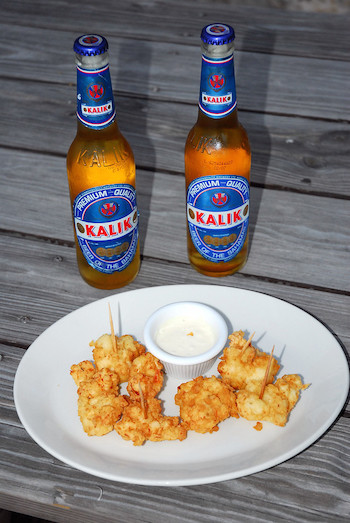
The anglers Bahamian special – Conch & Kalik. Photo: Jim Klug – Yellow Dog Flyfishing.
While technology initially allowed for growth in angling, screen time since the inception of the internet, laptops, and smartphones has generally been devastating for participation in outdoor pursuits. Most recently, however, COVID-related lockdowns that forced people out of homes, offices, theaters, gyms, and the like, anecdotally proliferated considerable growth in people interested in outdoor pursuits. How long the COVID-related influx of outdoor enthusiasts will last is unknown. The impacts of social media platforms need noting as these have, on the one hand, encouraged people to get outside and share experiences and, on the other, allowed “armchair” anglers to be a part of the community- the latter having little impact on actual fisheries (e.g. angling pressure, post-release mortality, travel related CO2 emissions). The implications of social media platforms like Instagram or YouTube require study, but they inevitably impact bonefishing, whether positively or negatively.
The volume of research on bonefish that has been conducted is now considerable. A significant body of research has allowed for a far better understanding of bonefish biology and effective conservation measures needed to protect these fish – and others. Anglers have more opportunities to learn about bonefish, and research organizations have better abilities to share their findings to improve catch rates, catch and release rates, and general awareness. Better-educated anglers with more simplified access to bonefish and easier to use equipment are angling trends that bode well for the future.
The Future
Where bonefishing evolves from the present is challenging to predict. Current trends, along with supporting science and modeling, suggest a mixed and complicated future. On the positive side, there is a large body of research on; bonefish biology with many successful cases of best practices in conservation management to emulate, a far better understanding of the implications of development, pollution, and habitat loss on ecosystems, and far more education. Anglers are arguably better informed about these issues recognizing their actions and voices play a considerable role in the future of all fisheries.
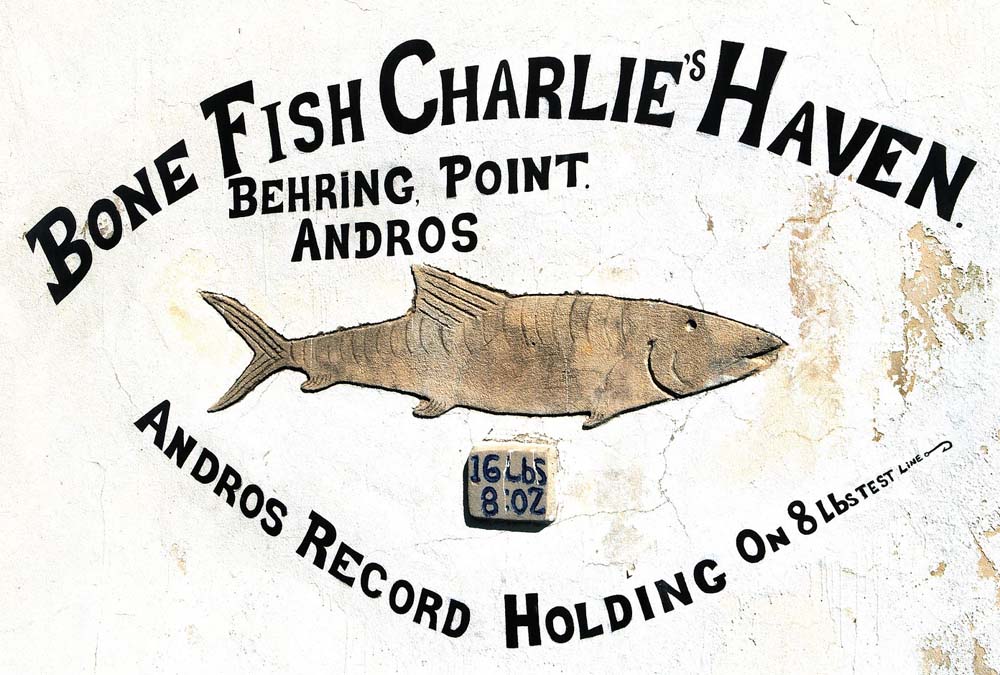
Photo: Jim Klug – Yellow Dog Flyfishing.
Our interconnected nature now allows for rapid dissemination of information and sharing by non-conventional means; this will continue or even accelerate. More people may be drawn into the sport thanks to better, faster, cheaper transport, easier access to once-remote destinations, and far better equipment, which makes fishing more accessible. As more enter the sport, supply and demand will impact associated markets and once financially out of reach equipment or angling destinations will be more available to a wider audience. More participants equal a larger voice when unified and educated. Hopefully, the voice is powerful enough to overpower interest groups whose intentions may not align with bonefishing, preservation of habitat, and conservation measures needed to support these fisheries. Misinformation and apathy, on the other hand, could reverse these potential future positive outcomes. So too could “over tourism” the overwhelming stress placed on destinations resulting from too many tourists.
Unfortunately, a considerable number of stresses are placed on coastal marine habitats, and the list is growing. For fear of leaving a doomsday scenario on readers, I will touch on only a few impacts. Still, it is important to recognize that any one factor in a given region could decimate flats fish, including bonefish, because of the nature of bonefish and the connectivity of the environments in which they reside. Tides and currents are difficult to contain in the event of habitat losses, and international borders make management practices challenging. When considered together, the net cumulative impact potentially facing future fisheries is overwhelming. For simplicity, only three potential effects are noted for ease of comprehension, while these impacts are intertwined, far-reaching, and very challenging to solve.
Human Population
In 2022 human population passed 8 billion people. Barring unforeseen negatives (war, famine, pandemics, etc.), projections place the human population at nearly 10 billion by 2050 and over 11 billion by 2100. Simply put, these are mouths to feed and heads to cover, all requiring resources from a finite planet. Traditional human settlements favor coastal environments, with estimates suggesting 60% of the population resides within 100km of a coastline. Coastlines are fixed; consequently, population density in these fragile environments will increase, and habitats will be transformed to accommodate more people. While this likely means more anglers, it is more likely the angling will not be recreational in nature, rather catch and release will be threatened, as more mouths need to be fed.
On land, agriculture will become increasingly intensive, and habitats will continue to be altered to suit the needs of a growing human population. Biodiversity will presumably continue to decline as lands are transformed into urban settings, and rural lands will increasingly be morphed for agricultural production. These issues, while far afield, do impact marine fisheries. More deforestation leads to warmer water, less groundwater recharge, and more erosion. Less groundwater recharge means more surface water extraction for use by humans; more erosion means lower quality soils, and more effluent into oceans and across flats. More agriculture leads to more associated runoff with higher nutrient levels, resulting in algae blooms, oxygen declines, and fisheries collapsing. It is reasonable to conclude that fishing intensity and aquaculture will increase in the oceans.
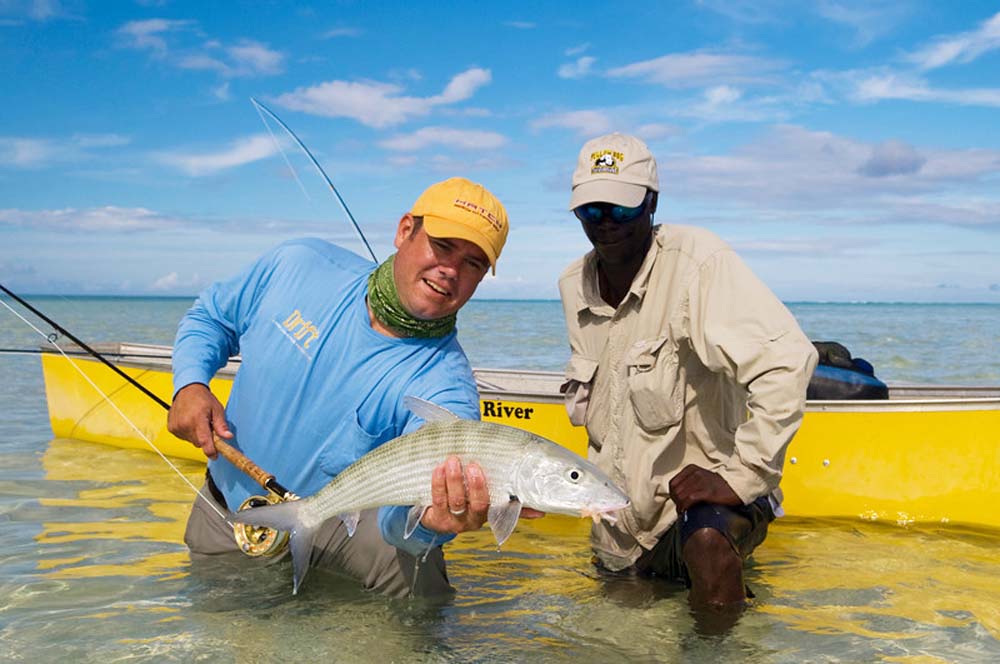
Photo: Jim Klug – Yellow Dog Flyfishing.
Global fish stocks
Global fish stocks are currently under great threat. At the current extraction rate, 34% of fisheries have been deemed overfished (as of 2017). Some studies have suggested fisheries will collapse by 2050. While predictions are difficult to make, there will be more people to feed, and more people will be residing along coastlines, which implies a greater reliance on mariner sources. As has been said so many times, desperate times call for desperate measures. This is especially true in the case of the basic necessities of life like food. Poverty and dwindling food supplies can predictably lead people away from conservation-based measures like catch-and-release angling, abiding by established marine harvest levels, or the like. Recreational fisheries, I fear, will be under greater threats as a result of the sheer necessity for food sources, especially in geopolitical
regions that are less economically affluent than North America.

Join and learn how to help your flats fisheries.
Climate change
Climate change has a lengthy list of potential impacts that will and are threatening fisheries, including bonefish destinations globally. Within the context of climate change, there are many sub-factors, each potentially impacting the future of bonefishing. Climate change leads to ocean acidification, sea level rise, changes in currents and meteorological patterns, increased ocean temperatures, more intense and frequent tropical storms, and shifting human populations.
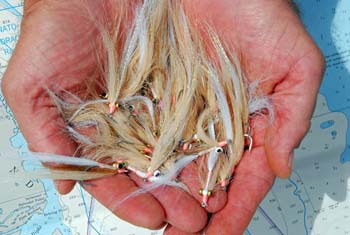
Dinner for a Bahamas bonefish. Photo: Jim Klug – Yellow Dog Flyfishing.
Ocean acidification leads to declines in species like shrimp, crabs, and shells because they can no longer produce hard shells. These are the primary forage food items for bonefish. Less food means less fish or shifts to other food sources or other habitats in search of food. Ocean acidification also leads to “coral bleaching” or coral death, leading to less coastline habitats and more coastal erosion.
Sea level rise will inundate coastal habitats making “flats” deeper and potentially no longer suitable for shallow-water fish species. Sea level rise also changes the salinity of oceanic water, and it changes ocean currents. Both of these will impact bonefish habitats.
Warmer oceanic water will shift bonefish populations or habitats as fish seek their preferred temperatures and dissolved oxygen levels. Higher water temperatures affect fish feeding and post-release mortality levels. Warmer ocean waters evaporate faster, fueling more intense and frequent storms. On shallow flats, the impacts of strong storms are far more intense than in deeper waters. Shoreline habitats can be scoured of vegetation vital for juvenile fish species and the food sources on which they rely.
Finally, all of these will impact humans and population density. Reduced coastline means shifts of people and densification of the growing population – more people on less land requiring more resources.
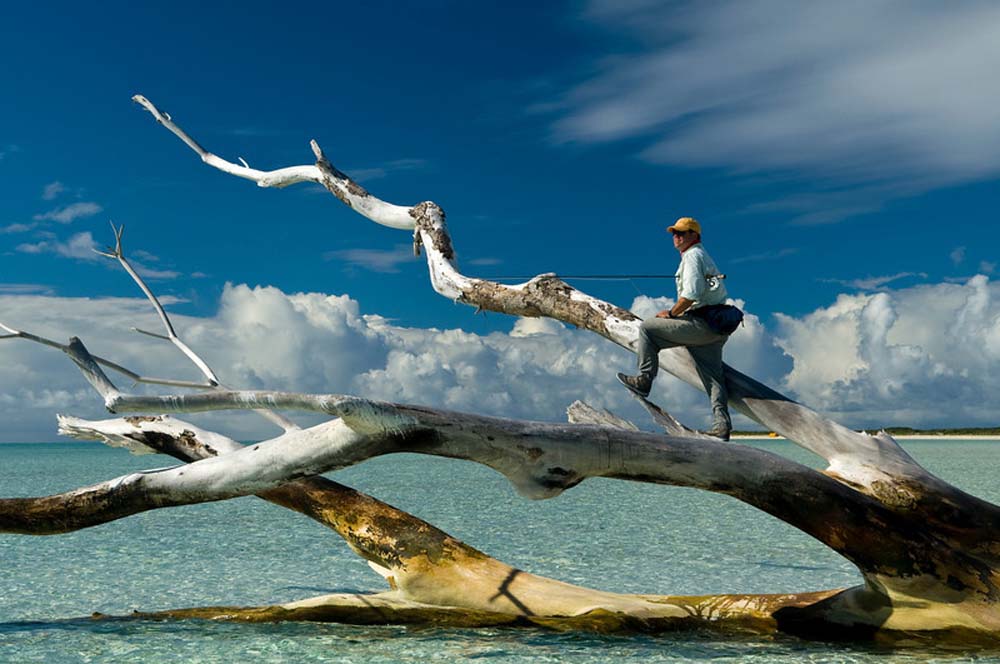
Photo: Jim Klug – Yellow Dog Flyfishing.
Other Potential Impacts
While human population, fish stocks, and climate change were noted above, there is a lengthy list of other factors, some small and some large. Pollution, social change/unrest, economics and poverty, geopolitics, and conflict can all be examined in depth with the outcome(s) that likely impact bonefishing or some angling destination we cherish at some level. It can be overwhelming to contemplate any of these impacts, and it is easy to become complacent or apathetic, yet as anglers, we need to fight for what we hold dear. We need to learn as much as we can, share that knowledge, bring more people into the sport, become more educated, more involved in conservation and preservation, and in turn, leave what we love for future generations to enjoy. We are the voices for the voiceless, be it the future generations that will follow us, the water that flows through rivers, country-sides, towns, and into oceans, the mangrove shorelines that support healthy fisheries, or the fish that inhabit them – we need to speak for them.
The future of bonefishing can be examined at various scales from many lenses. Depending on the point of view one takes, it can be a hopeless cause; a number of great organizations are doing research and using the results of that research to help protect these resources. Groups like Bonefish and Tarpon Trust, The Fisheries Conservation Foundation, and The Nature Conservancy have magnified our knowledge base. Technology now allows us as anglers to become more informed and better able to recruit others than ever. Thus while the future is difficult to predict, it is affected by our actions today.

This advertisement paid for by Tom Karrow. Click on ad . . .


